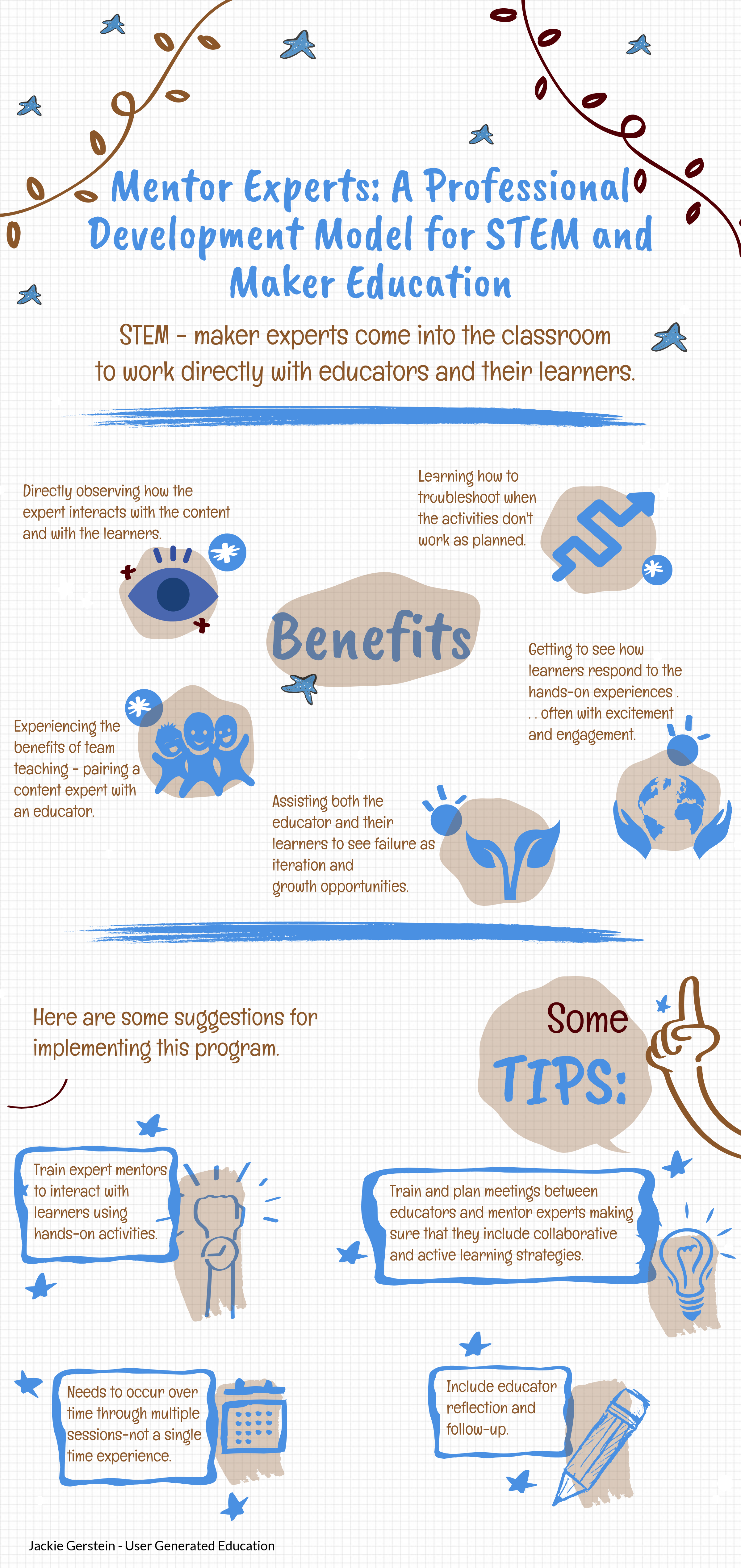Expert Mentors: A Professional Development Model for STEM and Maker Education Implementation
Implementing Maker, STEM, STEAM Education
In order to prevent STEM and maker education from becoming a flavor of the month, there needs to be specific strategies provided to educators on how to embed STEM and maker activities into their curriculum. A good number of educators have not received training on how to integrate activities into their classroom practices which entail resource heavy, hands-on learning.
One of the elementary schools where I work is going to implement maker education this coming school year. In a discussion with the principal and a small number of teachers, we realized that some of the teachers will be resistant due to their lack of experience with the activities, resources, and tools related to maker education, and frankly, their fear of doing something as foreign as maker education.
A key to increase their comfort with and chances for implementing these activities is to provide them with professional development opportunities, but the PD needs to be designed based on research.
Professional Development
Teacher professional learning is of increasing interest as a critical way to support the increasingly complex skills students need to learn in order to succeed in the 21st century. Sophisticated forms of teaching are needed to develop student competencies such as deep mastery of challenging content, critical thinking, complex problem solving, effective communication and collaboration, and self-direction. In turn, effective professional development (PD) is needed to help teachers learn and refine the instructional strategies required to teach these skills. (Effective Teacher Professional Development).
The Learning Policy institute examined rigorous studies that have demonstrated a positive link between teacher professional development, teaching practices, and student outcomes. They discovered that not all professional development experiences are equal and that effective PD has specific characteristics. Their findings included:
Active learning provides teachers with opportunities to get hands-on experience designing and practicing new teaching strategies. In PD models featuring active learning, teachers often participate in the same style of learning they are designing for their students, using real examples of curriculum, student work, and instruction.
Curricular models and modeling of instruction provide teachers with a clear vision of what best practices look like. Teachers may view models that include lesson plans, unit plans, sample student work, observations of peer teachers, and video or written cases of accomplished teaching.
Effective professional development provides teachers with adequate time to learn, practice, implement, and reflect upon new strategies that facilitate changes in their practice. As a result, strong PD initiatives typically engage teachers in learning over weeks, months, or even academic years, rather than in short, one-off workshops (Effective Teacher Professional Development).
After attending the New Mexico Computer Science week whereby engineering college students acted as mentors for the participating teachers, I realized that having experts in the classroom working directly with educator can be a great form of professional development. In this case, it was the engineering college undergraduates but it could also be trainers from STEM-related organizations or other educators who have developed their STEM instructional practices. This model has the potential to discuss the properties of effective professional development discussed above. Mainly, educators would be able to see STEM and maker instructional practices being modeled.
Benefits
- Directly observing how the expert interacts with their content and with the learners.
- Experiencing the benefits of team teaching – pairing a content expert with an education.
- Learning how to troubleshoot when the activities don’t work as planned.
- Assisting both the educator and their learners to see failure as iteration and growth opportunities.
- Getting to see how learners respond to the hands-on experiences . . . often with excitement and engagement.
Implementation Suggestions
Some suggestions for implementing this form of professional development follow. It obviously is just a beginning.
- Train expert mentors in interacting with learners using hands-on activities.
- Train and plan meetings between educators and mentor experts making sure that they include collaborative and active learning strategies.
- Needs to occur over time through multiple sessions – not a single time experience.
- Include educator reflection and follow-up as an integral component of the professional development.

An Example
An example of a mentoring program is my local area is the New Mexico STEM Mentor Collective.
The Northern New Mexico STEM Mentor Collective, funded by NSF INCLUDES (Inclusion across the Nation of Communities of Learners of Underrepresented Discoverers in Engineering and Science) seeks to raise aspirations and expectations in Middle & High School STEM (Science, Technology, Engineering and Mathematics) topics by training and planting (in local schools and libraries) a paid STEM Mentor Corps comprised of caring, exemplary NNMC (Northern New Mexico College) undergraduates
Even though it is designed to bring Engineering undergraduates into the classroom to provide young people with mentors, I contend it could also be used to help educators learn how to implement STEM and maker education activities. I am planning to work with my principal this coming school year to help develop this as a model of professional development.

Leave a comment